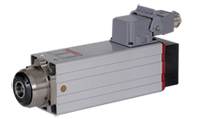SPINDLE MOTOR RPM:
Router or Precision Spindle
 Probably the most recognizable term associated with motors is RPM or revolutions per minute. Simply put, this term describes the rotational speed of a CNC spindle motor in “revolutions per minute.” Depending on what you are cutting this may or may not be important. Think about cutting Plexiglas versus MDF. Being able to adjust the rpm to the optimum point relative to the material being cut is of significant benefit. It prevents wood burning, plastic re melting and overall quality of cut etc. Probably the most recognizable term associated with motors is RPM or revolutions per minute. Simply put, this term describes the rotational speed of a CNC spindle motor in “revolutions per minute.” Depending on what you are cutting this may or may not be important. Think about cutting Plexiglas versus MDF. Being able to adjust the rpm to the optimum point relative to the material being cut is of significant benefit. It prevents wood burning, plastic re melting and overall quality of cut etc.
The rpm capabilities must match with the types of materials that you plan on cutting and the SIZE of cutters that you will be using. Tool life and cutter travel speed are greatly affected by the CNC spindle router’s rpm rating and your ability to adjust it. Analysis of your needs determines if you require a precision spindle for high performance and high speed or whether something like a Porter Cable 75182 router will do the job.
Need Higher RPM”S:
If you are mostly looking to do engraving then your CNC machine’s spindle must be capable of very high rpm or else your travel speeds must be reduced and run time will be longer than necessary. You’re looking for a “precision high speed spindle” with bearings that can handle the heat generated by this rotation.
 Most small engraving bits and mill ends are designed to run at 18,000 rpm or higher. If your spindle can handle this speed then you have the opportunity to maximize travel speeds and reduce working time, very relevant if you’re working in an industrial environment, less so if this is a hobby CNC application. Most small engraving bits and mill ends are designed to run at 18,000 rpm or higher. If your spindle can handle this speed then you have the opportunity to maximize travel speeds and reduce working time, very relevant if you’re working in an industrial environment, less so if this is a hobby CNC application.
High RPM’s are beneficial in any situation where the router bit is rated for higher rpm, the raw material you are cutting is soft enough and the wood removal is small enough to allow fast linear motion. High rpm’s lets you capitalize on your machines power.
Need Lower RPM’s?
If you are looking to use mostly large panel cutters then your CNC spindle router must be capable of low rpm’s (1,000-5,000 rpm range) or you will run the risk of burning out your cutters, so its not a bad idea to scan your tool library to get an idea on what you are using TODAY.
Always good to check with your tool supplier as they will have a specific MAXIMUM SAFE RPM running range for each router bit. Exceeding that can cause the cutter to blow up and result in some nasty accidents as the carbide comes flying off the body of the bit.
If you are cutting harder materials (aluminum, hardwood, and some types of plastics) then your machine must rotate slower to keep the cutter from heating up. Some woods like maple will char and some plastics will melt and fuse to the bit if the speed generates too much heat at the cutter. If the raw material is too dense to allow faster linear speeds then the only option is to reduce the tool’s rotational speed.
If you are using carbide cutters, the mainstay in the woodworking industry, the carbide is embedded in a cobalt binder. Excess heat reduces the ability of the binder to hold onto the carbide crystals, eventually losing abrasive content and dulling the blade. The hollow space left by the missing carbide now fills up with contaminates making it an even bigger problem. Bottom line is that heat is bad and costs cutters. Lowering rpm’s can be a solution if you have that functionality available to you.
For any one CNC spindle router ask for the specifications for the rpm range and match that to the tool specifications that you intent to use, then factor in what speeds you currently run at to reflect the type of material you cut. All this knowledge will help in making that ultimate decision on what CNC spindle motor buy is best for you. At this stage you are just developing the shopping list.
Intimately linked to that is a discussion about a CNC spindle motor’s torque and power rating
<< back to All about CNC SPINDLE MOTORS
| 
